phone TOYOTA GR86 2022 Owners Manual (in English)
[x] Cancel search | Manufacturer: TOYOTA, Model Year: 2022, Model line: GR86, Model: TOYOTA GR86 2022Pages: 582, PDF Size: 86.38 MB
Page 10 of 582
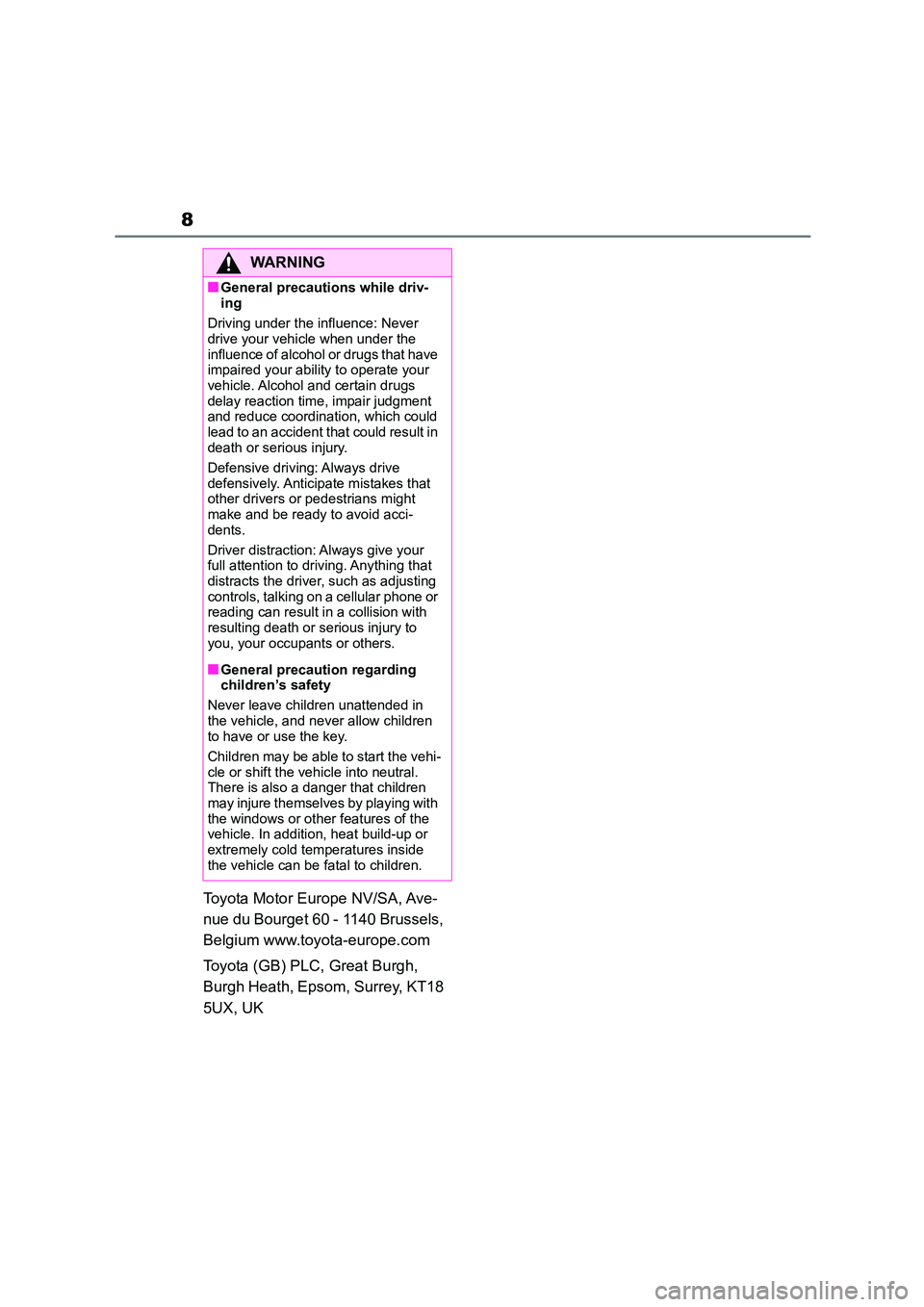
8
Toyota Motor Europe NV/SA, Ave-
nue du Bourget 60 - 1140 Brussels,
Belgium www.toyota-europe.com
Toyota (GB) PLC, Great Burgh,
Burgh Heath, Epsom, Surrey, KT18
5UX, UK
WA R N I N G
■General precautions while driv-
ing
Driving under the influence: Never drive your vehicle when under the
influence of alcohol or drugs that have
impaired your ability to operate your vehicle. Alcohol and certain drugs
delay reaction time, impair judgment
and reduce coordination, which could
lead to an accident that could result in death or serious injury.
Defensive driving: Always drive
defensively. Anticipate mistakes that other drivers or pedestrians might
make and be ready to avoid acci-
dents.
Driver distraction: Always give your
full attention to driving. Anything that
distracts the driver, such as adjusting controls, talking on a cellular phone or
reading can result in a collision with
resulting death or serious injury to you, your occupants or others.
■General precaution regarding children’s safety
Never leave children unattended in
the vehicle, and never allow children to have or use the key.
Children may be able to start the vehi-
cle or shift the vehicle into neutral. There is also a danger that children
may injure themselves by playing with
the windows or other features of the vehicle. In addition, heat build-up or
extremely cold temperatures inside
the vehicle can be fatal to children.
Page 18 of 582
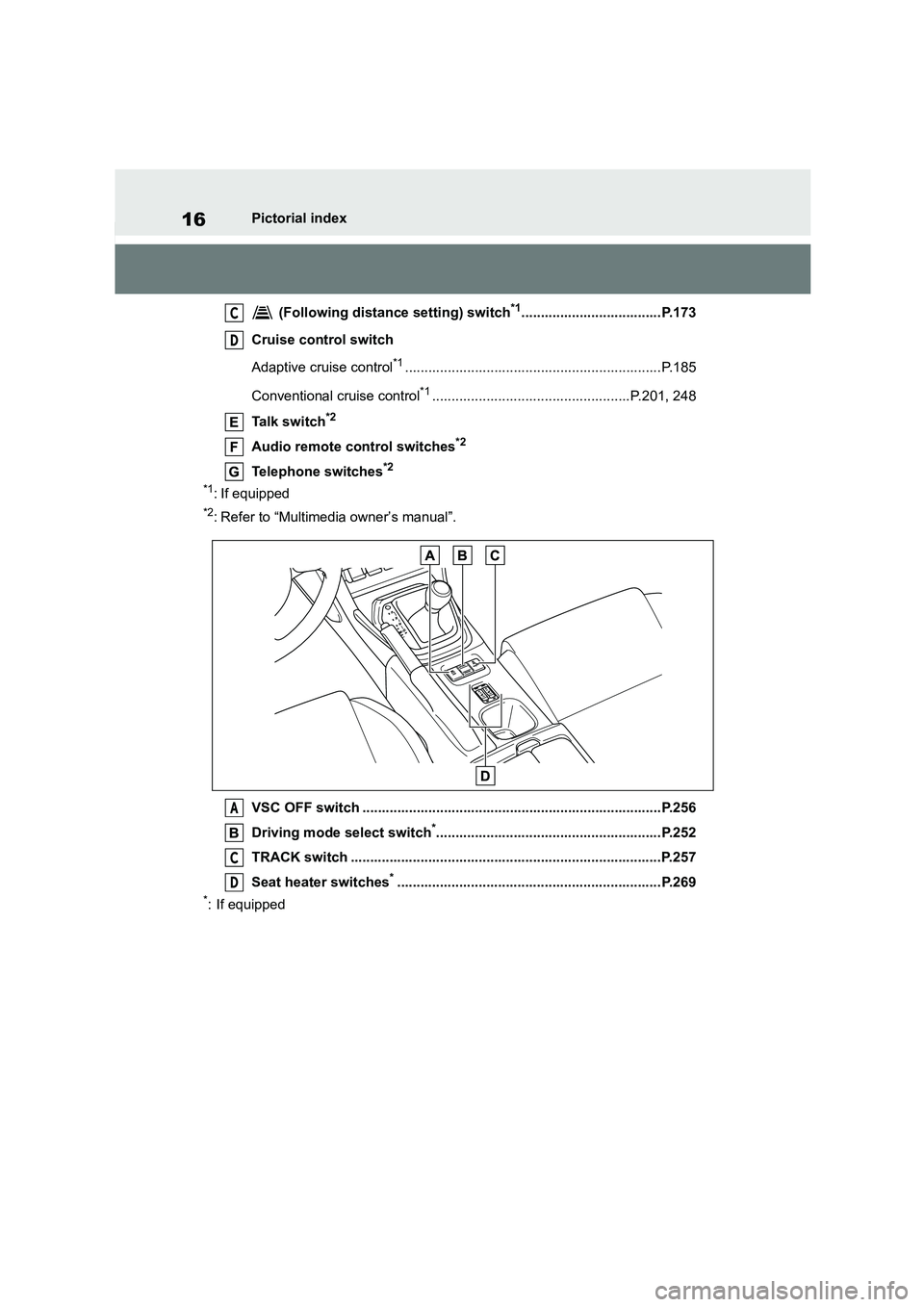
16Pictorial index
(Following distance setting) switch*1....................................P.173
Cruise control switch
Adaptive cruise control*1..................................................................P.185
Conventional cruise control*1...................................................P.201, 248
Talk switch*2
Audio remote control switches*2
Telephone switches*2
*1: If equipped
*2: Refer to “Multimedia owner’s manual”.
VSC OFF switch .............................................................................P.256
Driving mode select switch*..........................................................P.252
TRACK switch .............. ..................................................................P.257
Seat heater switches*....................................................................P.269
*: If equipped
C
D
A
C
D
Page 24 of 582
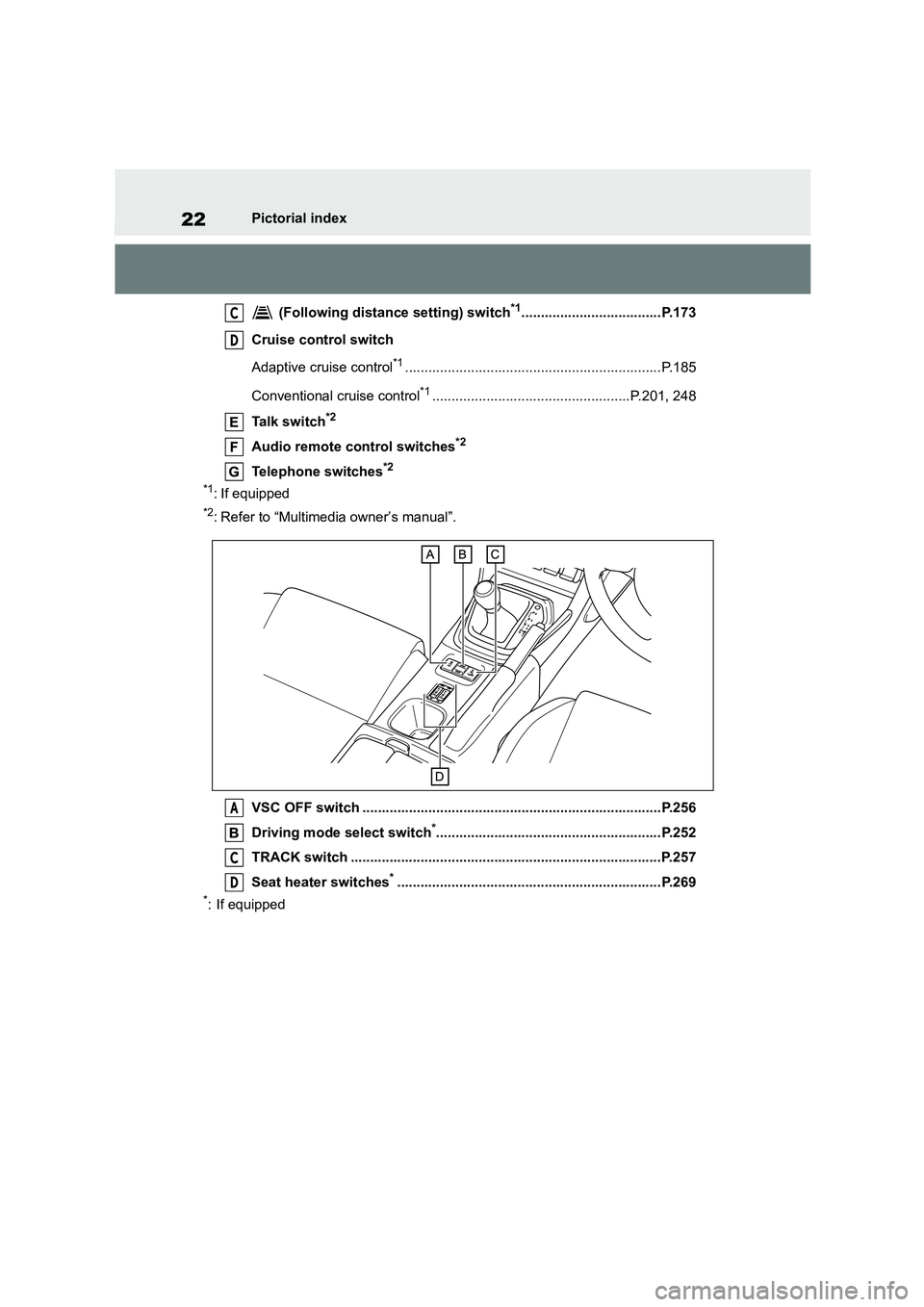
22Pictorial index
(Following distance setting) switch*1....................................P.173
Cruise control switch
Adaptive cruise control*1..................................................................P.185
Conventional cruise control*1...................................................P.201, 248
Talk switch*2
Audio remote control switches*2
Telephone switches*2
*1: If equipped
*2: Refer to “Multimedia owner’s manual”.
VSC OFF switch .............................................................................P.256
Driving mode select switch*..........................................................P.252
TRACK switch .............. ..................................................................P.257
Seat heater switches*....................................................................P.269
*: If equipped
C
D
A
C
D
Page 40 of 582
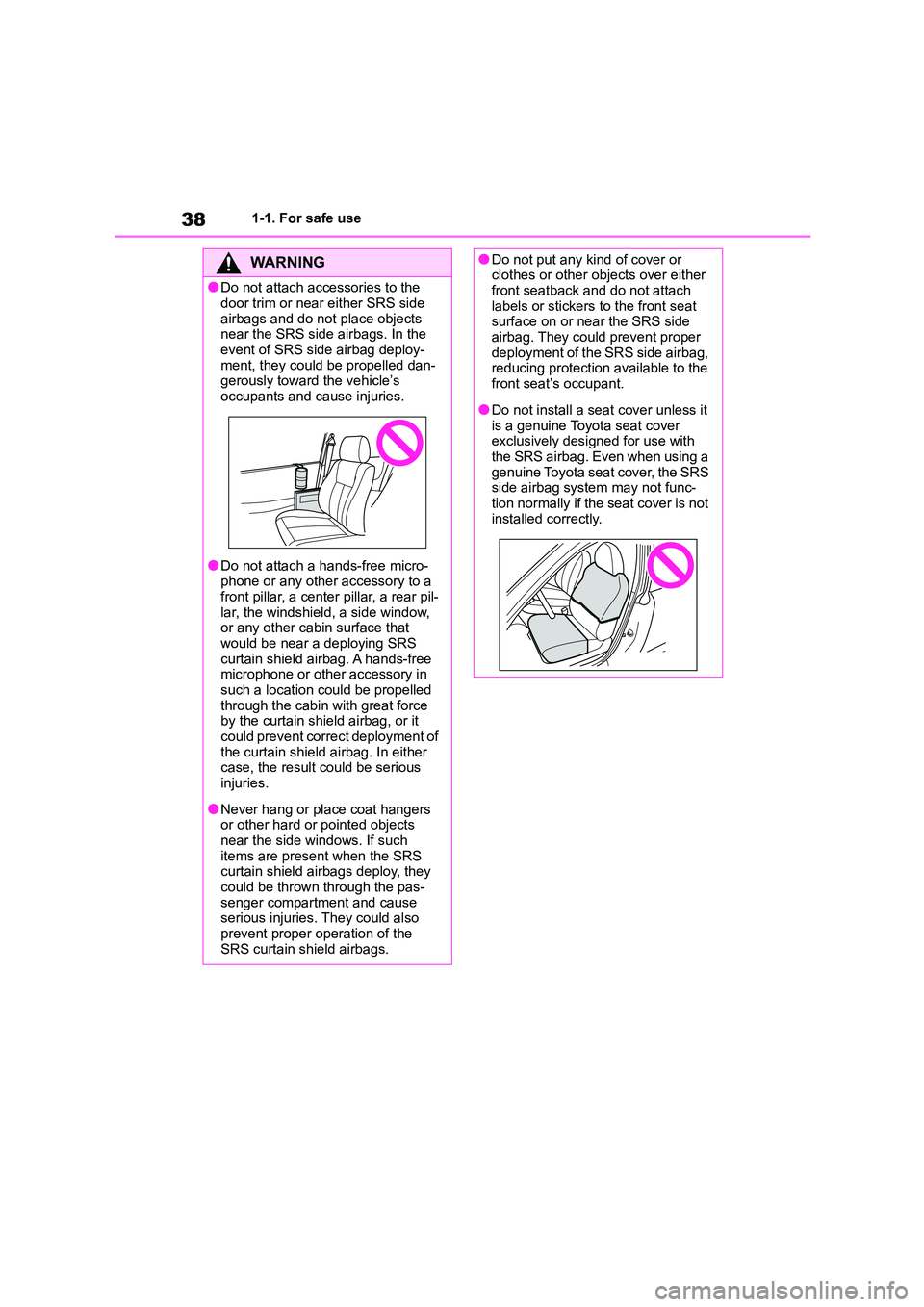
381-1. For safe use
WA R N I N G
●Do not attach accessories to the
door trim or near either SRS side
airbags and do not place objects near the SRS side airbags. In the
event of SRS side airbag deploy-
ment, they could be propelled dan- gerously toward the vehicle’s
occupants and cause injuries.
●Do not attach a hands-free micro- phone or any other accessory to a
front pillar, a center pillar, a rear pil-
lar, the windshield, a side window, or any other cabin surface that
would be near a deploying SRS
curtain shield airbag. A hands-free microphone or other accessory in
such a location could be propelled
through the cabin with great force by the curtain shield airbag, or it
could prevent correct deployment of
the curtain shield airbag. In either case, the result could be serious
injuries.
●Never hang or place coat hangers
or other hard or pointed objects
near the side windows. If such items are present when the SRS
curtain shield airbags deploy, they
could be thrown through the pas- senger compartment and cause
serious injuries. They could also
prevent proper operation of the SRS curtain shield airbags.
●Do not put any kind of cover or clothes or other objects over either
front seatback and do not attach
labels or stickers to the front seat surface on or near the SRS side
airbag. They could prevent proper
deployment of the SRS side airbag, reducing protection available to the
front seat’s occupant.
●Do not install a seat cover unless it
is a genuine Toyota seat cover
exclusively designed for use with the SRS airbag. Even when using a
genuine Toyota seat cover, the SRS
side airbag system may not func- tion normally if the seat cover is not
installed correctly.
Page 42 of 582
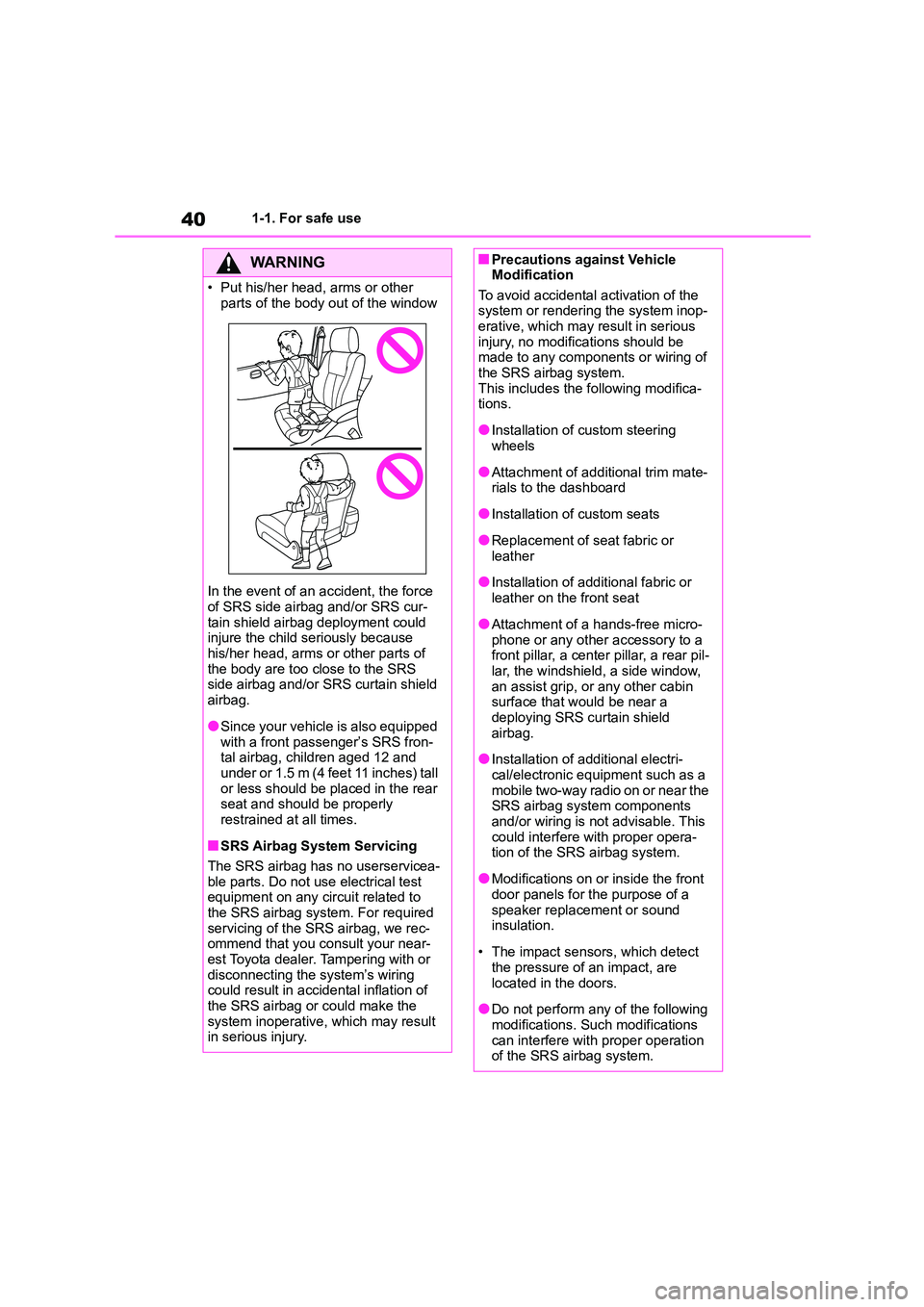
401-1. For safe use
WA R N I N G
• Put his/her head, arms or other
parts of the body out of the window
In the event of an accident, the force
of SRS side airbag and/or SRS cur-
tain shield airbag deployment could injure the child seriously because
his/her head, arms or other parts of
the body are too close to the SRS side airbag and/or SRS curtain shield
airbag.
●Since your vehicle is also equipped
with a front passenger’s SRS fron-
tal airbag, children aged 12 and under or 1.5 m (4 feet 11 inches) tall
or less should be placed in the rear
seat and should be properly restrained at all times.
■SRS Airbag System Servicing
The SRS airbag has no userservicea-
ble parts. Do not use electrical test
equipment on any circuit related to the SRS airbag system. For required
servicing of the SRS airbag, we rec-
ommend that you consult your near- est Toyota dealer. Tampering with or
disconnecting the system’s wiring
could result in accidental inflation of the SRS airbag or could make the
system inoperative, which may result
in serious injury.
■Precautions against Vehicle Modification
To avoid accidental activation of the
system or rendering the system inop- erative, which may result in serious
injury, no modifications should be
made to any components or wiring of the SRS airbag system.
This includes the following modifica-
tions.
●Installation of custom steering
wheels
●Attachment of additional trim mate-
rials to the dashboard
●Installation of custom seats
●Replacement of seat fabric or
leather
●Installation of additional fabric or
leather on the front seat
●Attachment of a hands-free micro-
phone or any other accessory to a
front pillar, a center pillar, a rear pil- lar, the windshield, a side window,
an assist grip, or any other cabin
surface that would be near a deploying SRS curtain shield
airbag.
●Installation of additional electri-
cal/electronic equipment such as a
mobile two-way radio on or near the SRS airbag system components
and/or wiring is not advisable. This
could interfere with proper opera- tion of the SRS airbag system.
●Modifications on or inside the front door panels for the purpose of a
speaker replacement or sound
insulation.
• The impact sensors, which detect
the pressure of an impact, are
located in the doors.
●Do not perform any of the following
modifications. Such modifications can interfere with proper operation
of the SRS airbag system.
Page 46 of 582
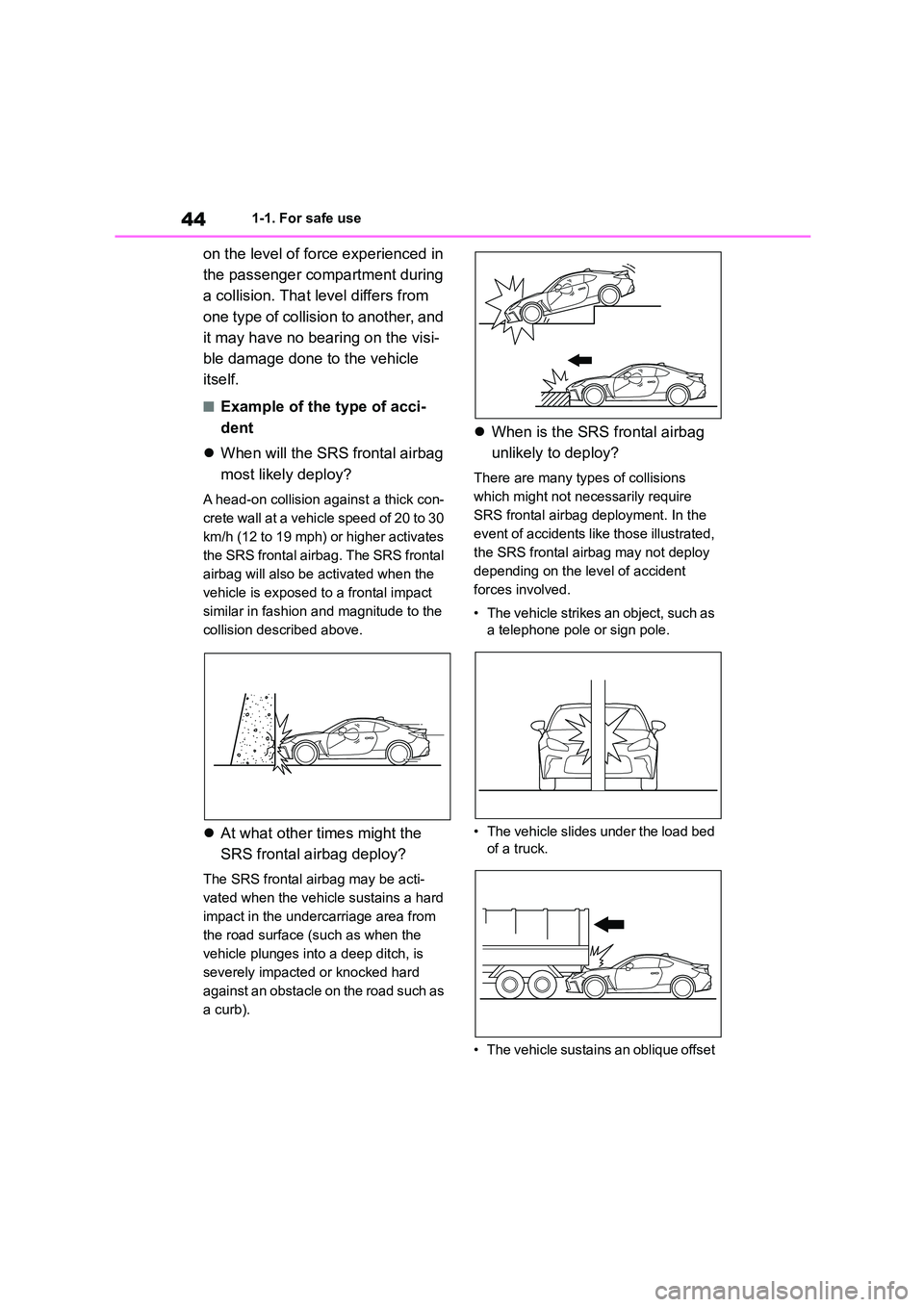
441-1. For safe use
on the level of force experienced in
the passenger compartment during
a collision. That level differs from
one type of collisio n to another, and
it may have no bearing on the visi-
ble damage done to the vehicle
itself.
■Example of the type of acci-
dent
When will the SRS frontal airbag
most likely deploy?
A head-on collision against a thick con-
crete wall at a vehicle speed of 20 to 30
km/h (12 to 19 mph) or higher activates
the SRS frontal airbag. The SRS frontal
airbag will also be activated when the
vehicle is exposed to a frontal impact
similar in fashion and magnitude to the
collision described above.
At what other times might the
SRS frontal airbag deploy?
The SRS frontal airbag may be acti-
vated when the vehicle sustains a hard
impact in the undercarriage area from
the road surface (such as when the
vehicle plunges into a deep ditch, is
severely impacted or knocked hard
against an obstacle on the road such as
a curb).
When is the SRS frontal airbag
unlikely to deploy?
There are many types of collisions
which might not necessarily require
SRS frontal airbag deployment. In the
event of accidents like those illustrated,
the SRS frontal airbag may not deploy
depending on the level of accident
forces involved.
• The vehicle strikes an object, such as
a telephone pole or sign pole.
• The vehicle slides under the load bed
of a truck.
• The vehicle sustains an oblique offset
Page 52 of 582
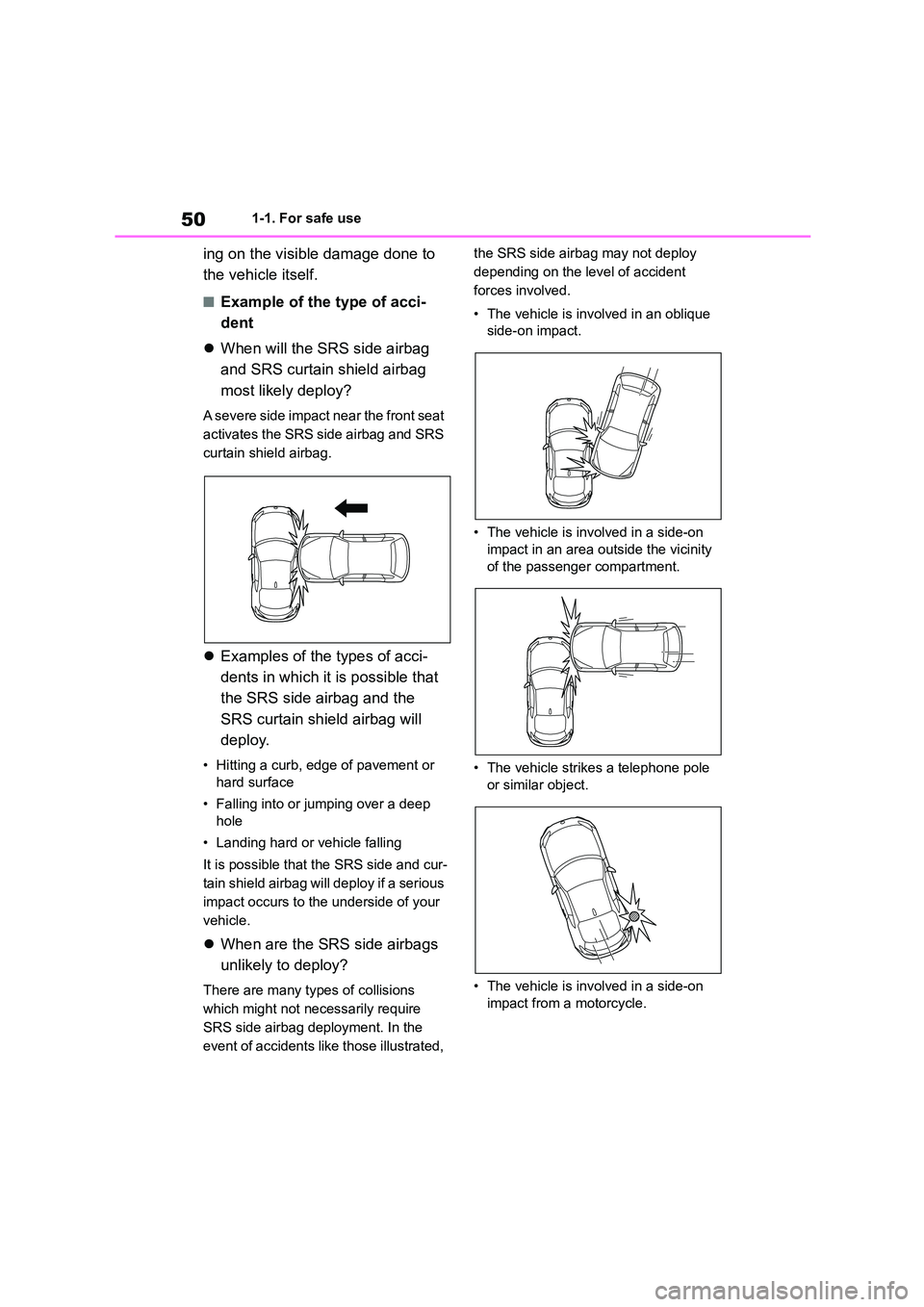
501-1. For safe use
ing on the visible damage done to
the vehicle itself.
■Example of the type of acci-
dent
When will the SRS side airbag
and SRS curtain shield airbag
most likely deploy?
A severe side impact near the front seat
activates the SRS side airbag and SRS
curtain shield airbag.
Examples of the types of acci-
dents in which it is possible that
the SRS side airbag and the
SRS curtain shield airbag will
deploy.
• Hitting a curb, edge of pavement or
hard surface
• Falling into or jumping over a deep
hole
• Landing hard or vehicle falling
It is possible that the SRS side and cur-
tain shield airbag will deploy if a serious
impact occurs to the underside of your
vehicle.
When are the SRS side airbags
unlikely to deploy?
There are many types of collisions
which might not necessarily require
SRS side airbag deployment. In the
event of accidents like those illustrated,
the SRS side airbag may not deploy
depending on the level of accident
forces involved.
• The vehicle is involved in an oblique
side-on impact.
• The vehicle is involved in a side-on
impact in an area outside the vicinity
of the passenger compartment.
• The vehicle strikes a telephone pole
or similar object.
• The vehicle is involved in a side-on
impact from a motorcycle.
Page 53 of 582

51
1
1-1. For safe use
For safety and security• The vehicle rolls onto its side or the
roof.
When is the SRS curtain shield
airbag unlikely to deploy?
There are many types of collisions
which might not necessarily require
SRS curtain shield airbag deployment.
In the event of accidents like those illus-
trated, the SRS curtain shield airbag
may not deploy depending on the level
of accident forces involved.
• The vehicle is involved in an oblique
side-on impact.
• The vehicle is involved in a side-on
impact in an area outside the vicinity
of the passenger compartment.
• The vehicle strikes a telephone pole
or similar object.
• The vehicle is involved in a side-on
impact from a motorcycle.
• The vehicle rolls onto its side or the
roof.
Page 72 of 582

701-3. Emergency assistance
1-3.Emergency assistance
*: Operates within the eCall coverage.
The system name differs depending
on the country.
Microphone
“SOS” button*
Indicator lights
Speaker
*: This button is intended for communi-
cation with the emergency operator.
Other SOS buttons available in other
systems of a motor vehicle do not
relate to the device and are not
intended for communication with the
emergency operator.
■Automatic Emergency Calls
If any airbag deploys, the system is
designed to automatically call the
PSAP (Public Safety Answering
Point).* The answering operator
receives the vehicle’s location, the
time of the incident and the vehicle
VIN etc., and attempts to speak
with the vehicle occupants to
assess the situation. If the occu-
pants are unable to communicate,
the operator automatically treats
the call as an emergency and con-
tacts the nearest emergency ser-
vices provider (112 system etc.) to
describe the situation and request
that assistance be sent to the loca-
tion.
*: In some cases, th e call cannot be
made. ( P.71)
■Manual Emergency Calls
In the event of an emergency, press
and hold the “SOS” button for more
than 1 second and then release it.*
The answering oper ator will deter-
mine your vehicle’s location,
assess the situation, and dispatch
the necessary assistance required.
eCall*
eCall is a telematics service
that uses Global Navigation
Satellite System (GNSS) data
and embedded cellular tech-
nology to enable the following
emergency calls to be made:
Automatic emergency calls
(Automatic Collision Notifica-
tion) and manual emergency
calls (by pressing the “SOS”
button). This service is
required by European Union
Regulations.
System components
A
C
D
Emergency Notification Ser-
vices
Page 73 of 582
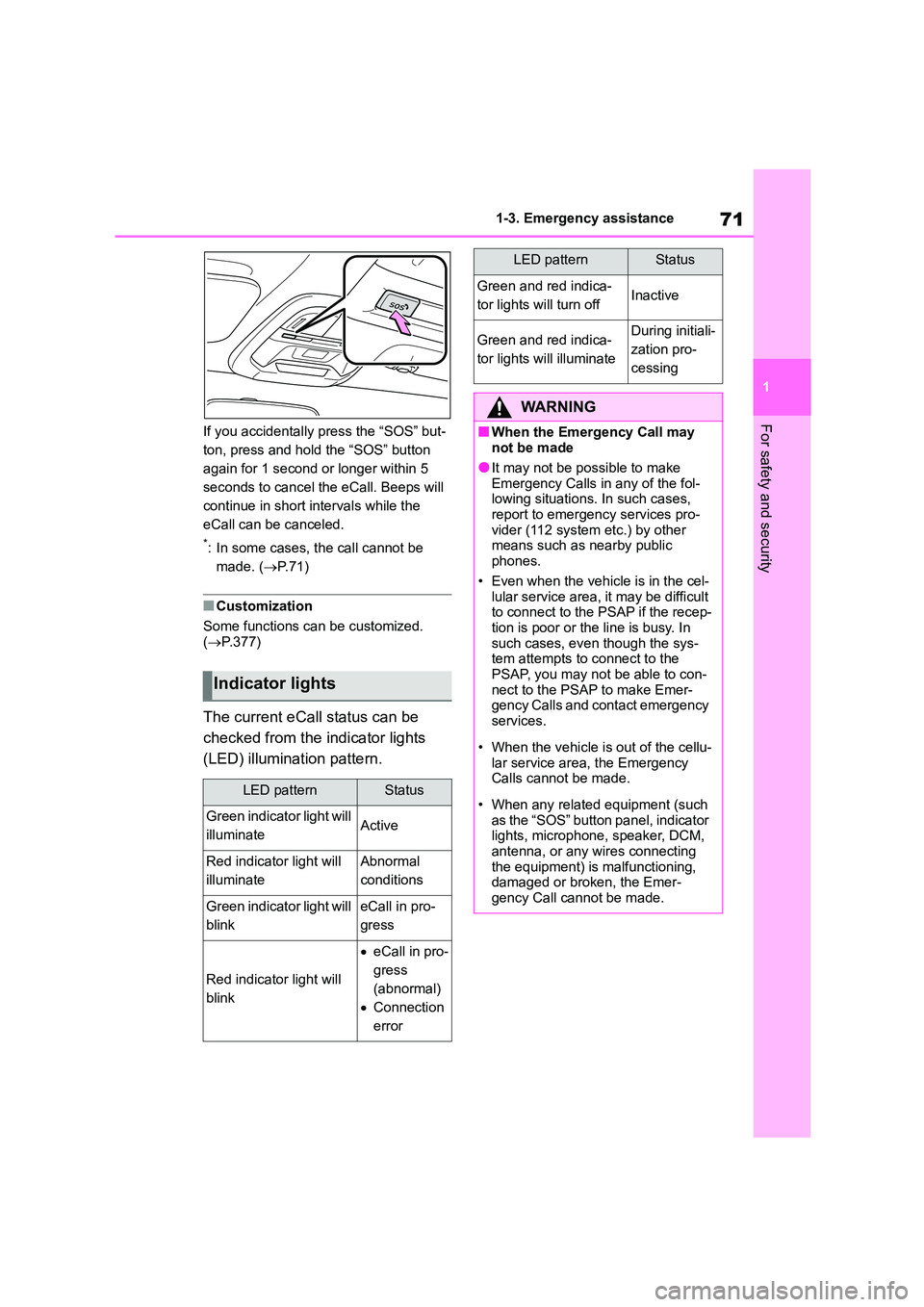
71
1
1-3. Emergency assistance
For safety and securityIf you accidentally press the “SOS” but-
ton, press and hold the “SOS” button
again for 1 second or longer within 5
seconds to cancel the eCall. Beeps will
continue in short intervals while the
eCall can be canceled.
*: In some cases, the call cannot be
made. ( P. 7 1 )
■Customization
Some functions can be customized. ( P.377)
The current eCall status can be
checked from the indicator lights
(LED) illumination pattern.
Indicator lights
LED patternStatus
Green indicator light will
illuminateActive
Red indicator light will
illuminate
Abnormal
conditions
Green indicator light will
blink
eCall in pro-
gress
Red indicator light will
blink
eCall in pro-
gress
(abnormal)
Connection
error
Green and red indica-
tor lights will turn offInactive
Green and red indica-
tor lights will illuminate
During initiali-
zation pro-
cessing
WA R N I N G
■When the Emergency Call may not be made
●It may not be possible to make
Emergency Calls in any of the fol- lowing situations. In such cases,
report to emergency services pro-
vider (112 system etc.) by other means such as nearby public
phones.
• Even when the vehicle is in the cel- lular service area, it may be difficult
to connect to the PSAP if the recep-
tion is poor or the line is busy. In such cases, even though the sys-
tem attempts to connect to the
PSAP, you may not be able to con- nect to the PSAP to make Emer-
gency Calls and contact emergency
services.
• When the vehicle is out of the cellu-
lar service area, the Emergency Calls cannot be made.
• When any related equipment (such as the “SOS” button panel, indicator
lights, microphone, speaker, DCM,
antenna, or any wires connecting the equipment) is malfunctioning,
damaged or broken, the Emer-
gency Call cannot be made.
LED patternStatus